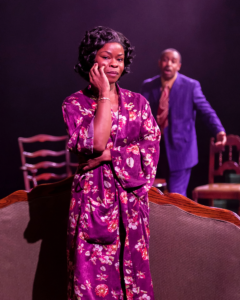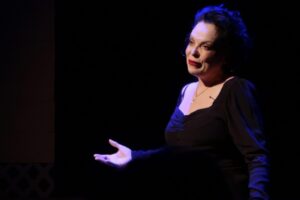LADY DAY AT EMERSON’S BAR & GRILL

Mom and Pop were just a couple of kids when they got married.
He was eighteen, she was sixteen and I was three.

As hard and tragic as Billie Holiday’s life was, she made some powerful, introspective songs that endure to this day. Grammy and Tony award-winning artist Diana Ross told her story in the 1972 film Lady Sings the Blues. Actress/singer and Tony award-winner Audra McDonald played Holiday in both film and stage versions in Lady Day at Emerson’s Bar & Grill. This production based on Holiday’s life, is the third version I’ve seen about the talented singer. Director Wren T. Brown’s is the best I’ve seen. One actress played her very rough. Every word that came from her mouth “bullshit” this and “effe you” that. In another version, Holiday was more of victim for her circumstance and became subdued. Holiday was either this or that nothing in between. Until now. Brown (Waiting to Exhale, Biker Boyz) was able to blend the roughhouse personality with tender vulnerability and created, what I believe, to be the real Billie Holiday. Karole Foreman (42) portrayed the artist with, sassiness and untapped rawness. She could still cuss up a storm when she becomes irritated, however, Foreman gave bits of humor making Holiday accessible to the audience. You can’t be a 24/7 bitch and expect people to root for you when you’re feeling lowdown. It doesn’t work like that.

She was born to teenage couple Sarah Julia Fagan, nickenamed Sadie, and vagabond musician Clarence Holiday. Papa was a rolling stone while Sadie found work wherever she could. This meant that Eleanora would stay with her aunt Eva Miller in Baltimore. It was a mean upbringing. Next door neighbor Wilbur Rich tried to rape Holiday when she was 11. At the same age she dropped out of school and took odd jobs, like scrubbing the steps at a home. And soon worked the streets like her mother. Sadie and Eleanora lived in a building that ran as a brothel and were employees. At age 14, Holiday became a sex worker, got busted and she and Sadie, or Duchess as Holiday referred to, went to prison.
By the time the audience see’s Holiday performance at Emerson’s Bar & Grill, in South Philadelphia on March 1959, she became a drug addict, heroin was the choice for many black performers back then, she met up with tenor saxophonist Lester Young (1909-1959) who blessed her with the nickname Lady Day and when she wasn’t calling him a mo-fo, she called him Prez. They were the best of friends. She worked with Count Basie got fired and was hired by and Artie Shaw, who showed tremendous respect for her. When she was forced to have meals in the kitchen, Shaw joined her. She had hit song after hit—“What a Little Moonlight Can Do,” “Strange Fruit,” “Fine and Yellow”— oddly enough, “Good Morning, Heartache” didn’t chart well in 1946. Lady Day was on fire!
Foreman does a remarkable and memorable performance as Holiday. She was smart, funny, and relatable and could out drink anyone of her male friends. When she sings one of her melodic songs, Foreman closes her eyes, says the words in such a tender way it’s impossible not to be affected. You feel Holiday’s pain, the loves she has lost and the aggravation of being mistreated because she was a black woman. Then, there are the stories of mistreatment she recalls. Like the time a white woman giving Holiday the mean side eye and with her twisted mouth told Holiday she’s not allowed anywhere except the stage. Holiday had to use the bathroom and Twisted Mouth wouldn’t let the singer use any of the bathrooms. Let’s just say that Holiday sprayed her discontentment all over Twisted Mouth’s clothing. Like a steady stream, the urine just shot out. It’s these little stories that bring out the more human side of the rough mouth jazz singer. She engages conversation with her pianist Jimmy Powers (musical director Stephan Terry) who doubles as her protector during her performance. She tries to get through “Strange Fruit,” but soon walks off stage. He plays a solo number until she returns and she does, and in better form. Terry’s role as Jimmy Powers probably stems from Holiday’s real live accompanist Bobby Tucker.
A few months after her performance at Emerson’s Bar & Grill, Holiday died in July 1959 at age 44 from liver and heart disease and diagnosed with cirrhosis of the liver. Prez died four months prior from alcoholism back in March 1959. Lady Day continues to survive and thrive. She was a fragile soul with a foul mouth, imbibed heavily and sang her heart out. The best Holiday story. That’s a legacy difficult to emulate but easy to admire. Foreman does a hell of a job in capturing the elusive soul of Holiday.
Lady Day at Emerson’s Bar & Grill plays until Sunday, March 1st at 3 p.m., Sunday, February 23rd at 3 p.m., Friday, February the 28th at 8 p.m., Saturday, 29th at 8 p.m. at The Nate Holden Performing Art Center located at 4718 W. Washington Blvd., in Los Angeles. For ticket information log on to wwww.ebonyrep.org.



